
Canadian Journal for Traditional Music (1974)
Ukranian-Canadian Folk Music of the Waterford Area
Background
For a period of eight weeks in May and June, 1974, we were engaged in recording Ukrainian music in the Waterford area, Norfolk County, Ontario.
The Ukrainian-Canadian population in the Waterford area is primarily involved in agricultural pursuits, although some of the people work in the factories in Brantford and other nearby urban centres, and farm part-time. All of our informants were either Ukrainian-born or first-generation Canadians. Although most of the population is bilingual, Ukrainian remains the preferred first language.
Much of the musical activity centres on the churches. These are: Greek Orthodox, Pentecostal, and Ukrainian-Greek Catholic. The Greek Orthodox and Ukrainian-Greek Catholic churches have choirs, while the Waterford Gospel Singers (a mixed vocal quartet with electric accordion) appear to fulfil this function within the Pentecostal church. As far as we were able to ascertain, the performance of sacred music during public worship services is largely restricted to the established church choirs: congregational singing does not appear to be prominent, although the corpus of sacred music is apparently quite familiar to the populace at large.
Musical activity in the area is at its peak in the winter, when choirs practice during the week and perform in church on Sunday as well. The repertoire of the choirs appears to consist mainly of traditional Ukrainian material, in addition to a few more recently composed items by well-known Ukrainian composers. The repertoire of the Greek-Orthodox choir also contains several selections composed locally by the current choirmaster. All sacred texts as well as secular are sung in Ukrainian.
While traditional Ukrainian sacred music is still thriving in the community, the secular songs have not fared as well. These, it would seem, are being rapidly forgotten. Our collecting project therefore focussed on secular songs as we felt that these would soon be lost, whereas the religious songs, because of the importance of the churches in the musical life of the area, would tend to survive much longer.
We were fortunate that one of the co-authors is a former member of the community. The project coincided in time with spring planting, a busy time in this farming community. If it were not for the fact that the co-author's family was well-known in the community it is doubtful if as many people would have taken the time to help us.
During the two-month stay in the area we managed to record a total of 23 secular items from 10 singers. While this collection by no means exhausted the repertoire of the singers, it is evident that requests for sacred materials would have yielded a much larger collection. All of the singers we approached had been at one time or another in one of the choirs. It may be that with the concentration of emphasis on religious songs, people felt ill-prepared when asked to sing non-religious songs.
Secular songs do not appear to have been passed on from one generation to the next on a large scale. Thus there is a discrepancy in the repertoires of different generations. Mrs. Gulka, who is eighty, performed songs for us which were not, for the most part, familiar to singers who were middle-aged. The younger people appear to know almost none of the older, traditional secular songs. The only young singers we found were the Waterford Gospel Singers, who contributed three religious songs which are direct from modem Ukraine. They know no specifically secular songs.
Thus, traditions of Ukrainian secular folk music appear to be dying out with the older generations. The decline is also evident in the realm of instrumental folk music. Traditional Ukrainian instruments are no longer in use. We found three cymbaly (an instrument of the hammered dulcimer family, such as the Hungarian cimbalon) which had been built by members of the community. The date of manufacture of these instruments was estimated by informants to be, respectively, c. 1960, c. 1945 and c. 1925. At present these instruments are in disuse. The sole surviving player of the cymbaly admitted that his demonstration of the instrument for us was the first time he had played it in "many years." He declined to have us record his playing. Other folk instrumentalists were located (piano-accordion, violin) but none are presently active.
Of course it is evident that our collecting of folk songs in the Waterford Ukrainian community was not of sufficient duration or intensity to allow us to explore in depth the amounts and kinds of Ukrainian musical survivals and/or adaptations which exist, nor to thoroughly investigate Old World musical survivals versus New World musical adaptations — and the cultural context of all of the above. Hopefully, additional field research into this interesting musical community will be possible in the future, and some of these fundamental questions can be broached.
Acknowledgements
Our fieldwork was funded by a grant from the Canadian Government's "Opportunities for Youth" Programme. We wish to thank Professor Robert Witmer, Assistant Professor of Music at York University. His advice and guidance proved invaluable in conducting this research. Our sincere thanks are due to the members of the Waterford Ukrainian-Canadian community for their hospitality, and for consenting to act as "informants": Max Taupeka, Philip Zackamarko, Mrs. Romanishun, Mr. Steve Dwornick, Mrs. Rudkow, Mrs. Gulka and the Waterford Gospel Singers. A special debt of gratitude is owing the following two individuals: Lorraine Dobrovolsky and Roksolana Ilnyckyj, as they provided the English translations for the Ukrainian song texts used in this study.

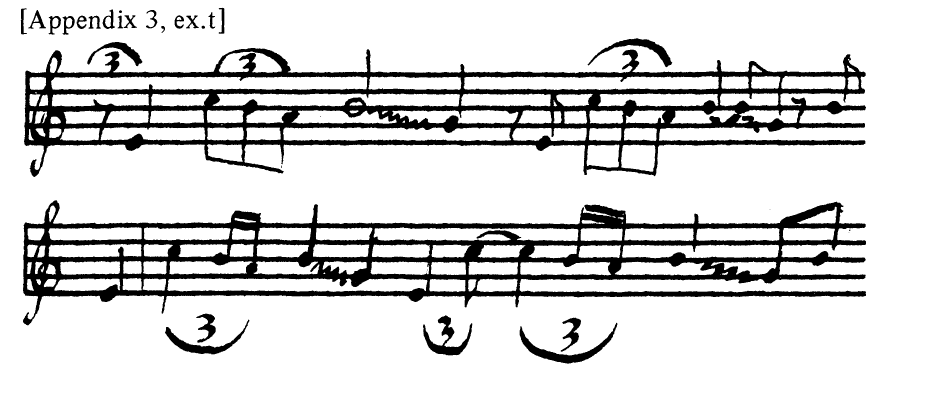
Appendix 1
Singing Styles
The Ukrainian singers prefer a full vocal sound with a strong vibrato. Except for slow ballads (of which we collected only one, ex. j), the songs are performed very loudly and forcefully. Glissandos are quite common. Only one singer, Max Taupeka, uses any other ornamentations:
The singers often varied the phrasing and pulse of the melody. This may be partially accounted for by the lack of instrumental accompaniment and by the fact that many of the performers had difficulty remembering the songs. These variations occurred, however, only when there was a solo voice, which suggests that melodic variation is part of the singing style.
Textual Content of the Songs
In terms of textual content, the songs we collected would appear to fall into four main categories:
(1) Love Songs: These songs can be divided into groups. One group utilizes a subjective approach, presenting the views and feelings of one of the lovers. The other group is objective in that it provides the views of both the man and the woman. An example of the first group is "Dark Eyes" (appendix 3, ex. r). An example of the second group is "Dark I Am Dark" (ex. 2).
(2) Narrative Ballads: The story of Halya (ex. 1) is an example of this group.
(3) Lyrical Songs: This category contains two songs. "Why, Why, Why", (ex. 3), collected from Mrs. Gulka, is a nostalgic, sad song which she likes because it reminds her of the Ukraine. Mr. Dwornick's song of the grave (ex. 6) is similar to Mrs. Gulka's song in that both deal with the remembrance of the past.
(4) Songs with Religious Content: This grouping contains five songs, three from the Waterford Gospel Singers, and one each from Mr. Dwornick
The most distinguishing characteristic of European folk songs is their strophic structure. The tune is repeated several times, each time with different words. This repetition determines the number of verses and the length of the song. European folk poetry lends itself to this melodic treatment since poems are arranged into units of two, three, four, five or six lines. Each unit is called a strophe or stanza and has an individual form which is repeated. The text coincides with the music in regard to phrases and cadences. There is also a close relationship between stress and accent of the word structure and the music, and the length of the tone and the syllable. 15
In most Anglo-American folk songs the stanza is taken as the essential unit. English folk song, for the most part, is put in lines of four stresses with a marked break in the middle. The lines generally group themselves in couplets which are not necessarily rhymed. The most common pattern consists of two couplets which have a rhyming arrangement occurring at the end of each line or every second line, thus emphasizing the binary nature of the stanza.1 6 The Maritime folk song, "Six Girls," may be seen as an example of this rhyming arrangement. The first stanza reads:
Once I was a lady's charmer but I'm unhappy now,
For courting six girls all at once to serve me anyhow.
Ma said that it was wicked but I laughed at her advice,
I knew it was very naughty but also very nice.17
Repetition is one of the most important characteristics of the folk song. It is a primary organizing principle since it performs many functions. It establishes a sense of familiarity within a certain piece enabling the audience to follow and sympathize and empathize. It aids memory and identification of its listeners to a point of involvement with the art. The melody is the most often repeated element, intensified in some cases by refrains and choruses.
Bruno Netti reports that wandering melodies is the term given to tunes whose variants were found firmly fixed in the folk traditions of widely separated countries, often using widely-varying texts. Scholars who have discovered this phenomenon are unable to prove whether or not the tunes had migrated.
Folk Song Style
Alan Lomax points out that song is "a complex human action since it is music plus speech, relating performers to a larger group in a special situation by means of certain behaviour patterns which give rise to a common emotional experience."1 9 Because of this, he proposes a new science of musical ethnography based on the study of the musical styles and musical
15Bruno Netti, Folk and Traditional Music of the Western Continent (Englewood Cliffs, N.J.: Prentice-Hall, 1965), pp. 34-37.
16Abrahams and Foss, Anglo-American Folk Song Style, p. 62.
17Creighton, Maritime Folk Songs, p. 128.
18Abrahams and Foss, Anglo-A merican Folk Song Style, p. 62
19Alan Lomax, Folk Song Style (New York: Folksong Center, Reprint Series No. 1, 1960), p. 928.
habits of mankind. He believes the "term style gives a sense of dynamic current."20 A style is a result of a certain group of practices, while at the same time it is the goal of the culture. It represents the intention of a culture.
Lomax believes that the study of musical style should embrace the human situation which produces the music. This would include the number of people habitually involved in a musical act and the manner in which they cooperate; the relationship between the music makers and the audiences; the physical behaviour of the music makers (body stance, gestures, facial expressions); the pitch and vocal timbres favored by the culture; the social function of the music, and the occasion of its production; the psychological and emotional content expressed by the song texts and the interpretation given this traditional poetry by the culture; and, finally, how songs are learned and transmitted.2 1
A musical style is learned by the people as a whole and responded to by members of specific cultures. The learning of the style is a gradual process for the child as he acquires the language and emotional patterns of his society. It would seem that as people live, so do they sing.
Folk Song Structure
The formal structure of the music itself is of utmost importance. This includes scales, the interval systems, the rhythmic patterns, the melodic contour, the harmonic techniques, the metric patterns of the verse, the structure of the poetry, the complex interplay between poetic and musical patterns, and accompanying instruments and instrumental techniques. Netti stresses the importance of making a careful examination of the basic structure of folk songs although he emphasizes that understanding the music comes much more easily through listening to it than reading about it. It is only after aural understanding that written analysis is meaningful.22
In making a study of folk song for its form, the size and number of sections are considered, and whether they are contrasted, repeated, or varied, as well as their overall relationship. The arrangement of performance as to solo, chorus, unison, harmony, or alterations is also important. The AABA form so often considered typical of folk song is only one of many possibilities.
The scale or mode on which the folk song is structured gives it one of its distinguishing characteristics. It may be built on the five-tone pentatonic scale, the major or minor scale, or any one of the modes — Dorian, Phrygian, Lydian, Aeolian, Mixolydian, or lonian.
The melody of folk song has been of great interest to the students of folk music and often the most difficult to describe. It is necessary to know whether the melody generally rises, falls, remains at the same level, or moves by steps, skips, or leaps. The range is of great importance and may be partly determined by the scale or mode on which the selection is based. The melody is often determined by the meaning and content of the text.
20Ibid p. 929.
22Nettl, Folk and Traditional Music of the Western Continents, p. 16.
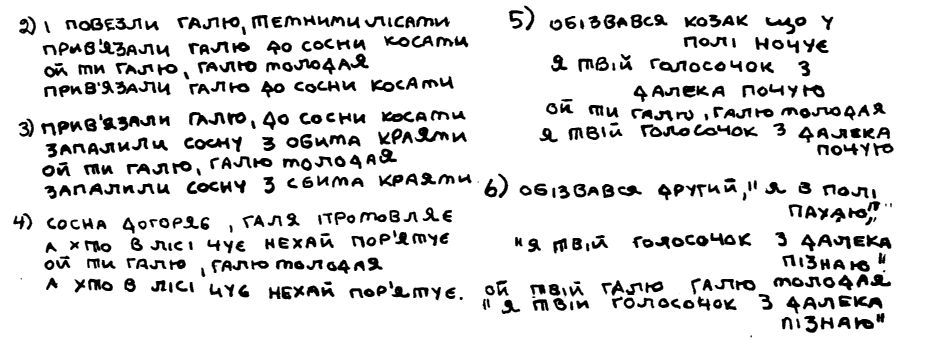

and Mrs. Gulka (see examples 4 and 5). We were unable to discover whether or not any of these songs are being performed in the churches today. -
Appendix 2
The transcriptions which follow are of two types. Those which include the text of the first stanza with the melody are transcriptions done directly from the tapes. Those which place the texts underneath the melody use an abstracted version of the song. Translations of the texts are for the most part literal.
1) The Cossacks were going home from war. They tricked Halya and took her with them. Oh you Halya, young Halya, They tricked Halya and took her with them.
2) And they drove Halya through the dark forests. They tied Halya to the pine with her braids. Oh you Halya, young Halya, They tied Halya to the pine with her braids.
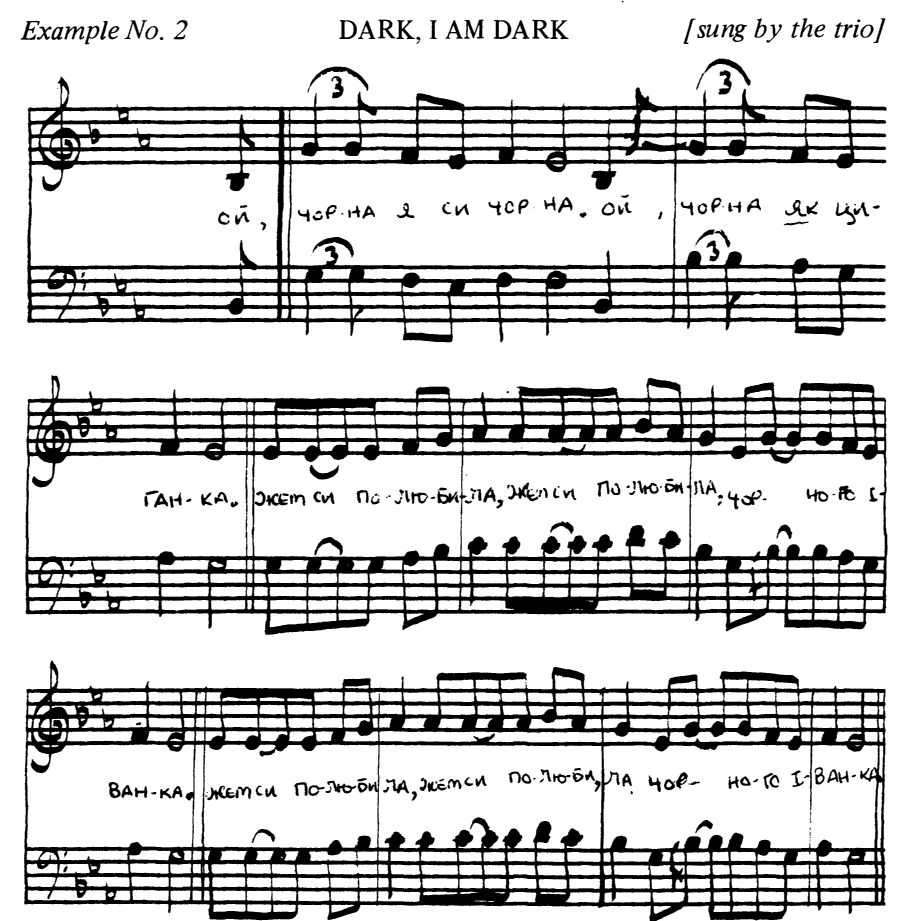
They tied Halya to the pine with her braids.
They set the pine afire from both sides.
Oh you Halya, young Halya,
They set the pine afire from both sides.
The pine burns, Halya speaks.
Anybody in the forest who hears her, let them save her.
Oh you Halya, young Halya,
Anybody in the forest who hears her, let them save her.
A Cossack who sleeps in the field answered her:
"I will recognize your voice from afar," Oh you Halya, young Halya, "I will recognize your voice from afar."
Another Cossack standing in the field also answered:
"I recognize your voice from afar." Oh you Halya, young Halya, "I recognize your voice from afar."


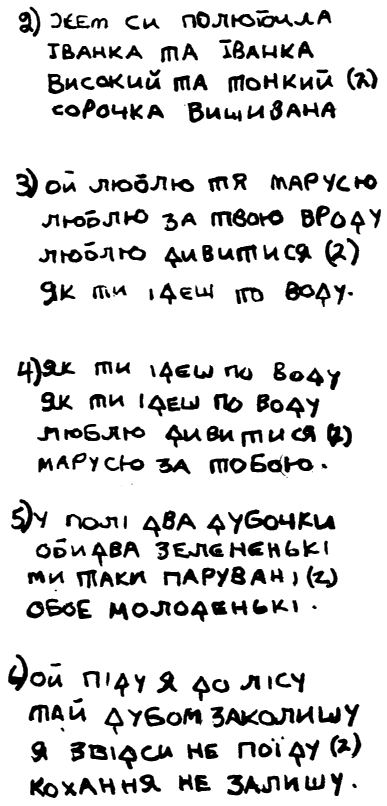
1) Dark, oh I am dark,
Dark as a gypsy.
Why have I fallen in love with (twice)
The dark Ivanko?
2) Oh yes I have fallen in love with
Ivanko, yes Ivanko.
Tall and stately (twice)
He wears an embroidered shirt.
3) I love you, Marusia,
I love you for your nature.
I love to watch you (twice)
As you go for the water.
4) As you go for the water (twice) I love to look (twice)
Marusia, after you.
5) In the field there are two oaks,
Both of them are green.
We are so matched, (twice)
Both of us are dark.
6) Oh I will go into the forest,
I will rock the oak.
I will not leave this place (twice)
I will not leave my love.


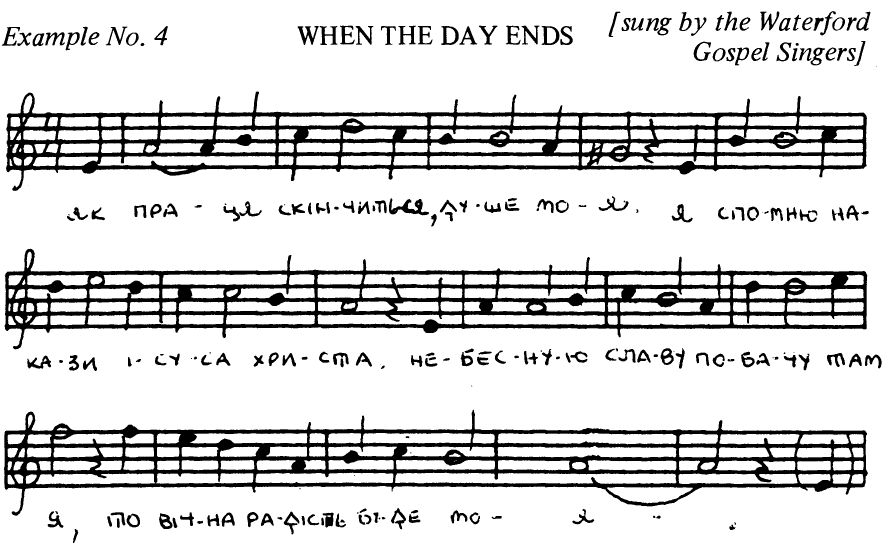
Why, why, why, oh my earth,
Why are you so dear to me? (twice)
Why, why, why, oh my earth,
Does your beauty so charm me?
With what, with what, with what do you charm me?
Your birdsongs, your vivid flowers of the forests.
With what, with what, with what do your waters enchant me?
Your currents that run here.
With that, with that, with that, know, my child,
Because here you first saw the flower, here in the summer meadow.
With that, with that, with that, know, my child,
Because these mountains, these forests, are your own country.
Here, here, here are your ancestors.
Here they spilt their blood for their faith in freedom.
Here, here, here are all your closest,
My heart, and your loved ones.
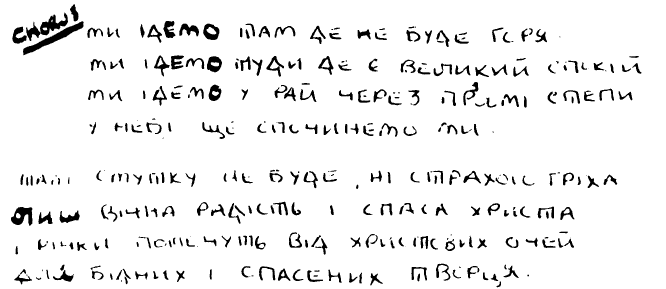

1) When this work finishes, my soul,
And when I remember the teachings of Jesus Christ, I will see heavenly glory there
And eternal joy wifi be mine.
Chorus We will go where there will be no tragedy.
We will go where there will always be great peace.
We are going to the holy gates through the level steppes.
We will rest in heaven.
2) There will be no sadness nor terrible sin,
Only eternal happiness in the Saviour Christ.
And rivers of tears will flow from Christ's eyes
For his loyal and saved children.
Chorus.
3) Let us try, brethren, to join, here. Reward awaits His loyal flock. In the heavenly city, together with Christ, We will govern forever.
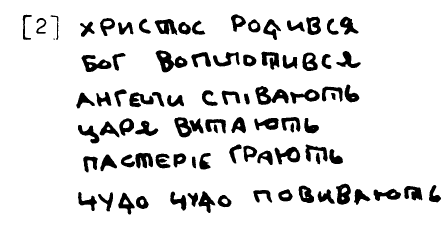
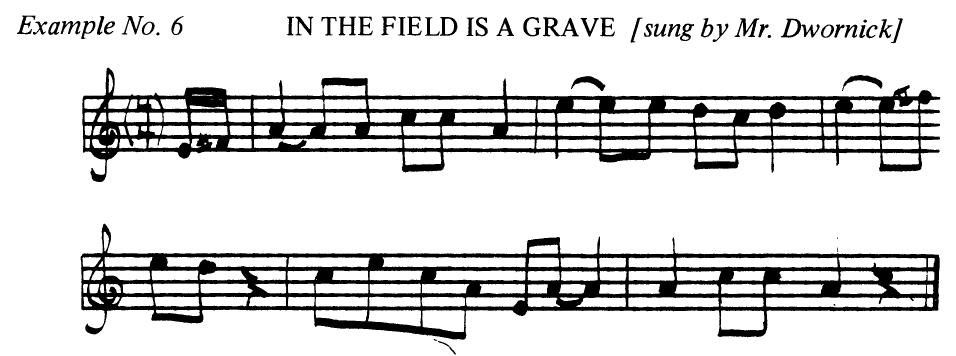
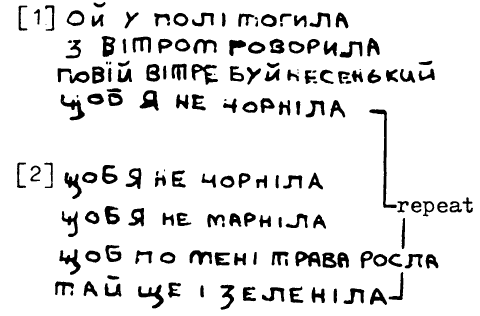
Heaven and earth (twice)
Today are celebrating
Angels and people (twice)
Merrily triumphing.
Christ is born
God has given birth.
Angels are singing
They are welcoming the Prince.
The shepherds are praising,
They are telling of the miracle.
In the field is a grave.
It was talking with the wind:
"Blow, lively wind, — So that I do not grow black."
"So that I do not grow black.
So that I do not become shabby.
So that grass grows over me.
So that I can be green."
2] Mr.Taupeka
3]
Mr. Zackamarko
4] Mr. Dwornick
5 1 \Vaterford Gospel
Singers
6] Mr.
Mr.
Taupeka
Zackamarko
7] Mr. Zackamarko Mrs. Romanishun Mrs. Rudkow
8] Singers as above [7] plus Mr. Taupeka
h) The Moon Is In The Sky
i) Such a Night, Oh God
j)
k)
1)
m)
n) When The Day Ends
o) LeBoLeBo
p) This Is The Way I Serve You q) Oh Holoburladra
r) Dark Eyes
s) Dark, IA m Dark
t) Halya.
u) Cucumber Song
v) My Mother Was Beating Me
The moon is in the sky
Such a night, God, moonlit and starry
When I remember my dear old country
It rustles, it roars
In the field is a grave
Heaven and earth
When this work finishes, my soul
In that night when I was praying
I want to sing in praise of Jesus Christ
Oh Holoburladra, and whom dic
she detain
Dark eyes, black brows
Dark, oh I am dark
The Cossacks were going home from war
I will plant cucumbers close to the water
My mother was beating me
York University, Weston, Ontario
Résumé: Anthony Proracki et Alan Henderson ont recueilli, l'été dernier, de la musique folkiorique Ukrainienne dans la region de Waterford, Ontario. Dans ce premier rapport de leurs découvertes, ils résument sommairement le genre de chants qu'ils ont enregistrés et en donnent des exemples avec traductions en langue anglaise.
© Canadian Journal for Traditional Music